Though green technology is creeping into marine engineering with the likes of Damen Shipyards’ ASD 3212 diesel-electric-propelled "Green Tug," transhipment between factory and project base relies almost exclusively on conventional vessels. Notable exceptions are Vestas’ two custom-built Bladerunner boats which move blades from the company’s R&D facility on the Isle of Wight to Southampton port for transhipment, and Enercon’s E-Ship 1 which, fittingly, harnesses wind power to help transport wind turbine components.
 |
| Damen's revolutionary ASD 3212 Green Tug reduces CO2, SOX and NOX emissions by 30% |
E-Ship 1 has four 27 meter-high Flettner rotors mounted on its deck. These are spun up using excess energy derived from the diesel engines’ exhaust gas, so making use of the force a spinning body in a moving airstream produces (the Magnus Effect) to help drive the ship. The same force is what causes the curved motion of a spinning football or cricket ball. This extra power reduces fuel consumption by up to 40 percent, and the ship’s adjustable cargo bay also lets it load many more wind turbine components than a conventional cargo vessel of the same size.
 |
| E-Ship 1 has four 27 meter-high Flettner rotors mounted on its deck |
Transhipment also brings its own quayside challenges. For very heavy items such as nacelles, built-up towers and jackets, Collett uses self-propelled modular transporters (SPMTs) that have been used for many years in sectors like oil and gas, and petrochemicals.
"Moving blades up to 60 meters and nacelles between 200 and 400 tons is completely possible, but that’s strictly between the quayside and the storage area," says Collett. "You work out the number of axles you need and bolt them together."
Netherlands-based transportation specialist Wagenborg used SPMTs in various configurations to load out the REpower nacelles and rotors for the Alpha Ventus field last year. 20-axle lines of Scheuerle SPMTs transported complete rotors with diameters of between 116 and 118 meters, and weighing nearly 150 tons each, while the vast tripod foundations required a set of 22+8 axle SPMTs under each leg. To add to the challenge, the rotors had to slide right out over the dockside before the barge cranes were able to pick up the load.
 |
| 20-axle lines of Scheuerle SPMTs transported complete rotors with diameters of between 116 and 118 meters, and weighing nearly 150 tons each |
The trip to the field is the next leg of the offshore turbine journey. Increased efficiency and lower costs are again the goal: offshore installation as a proportion of total CAPEX is predicted to fall from 23 percent to 18 percent by 2020, and innovative technology is paving the way.
Suction bucket footings are also quick and cheap to install in soft seabed conditions. Mercon and ALE’s new EMI technology uses a standard barge equipped with a tilting frame in order to install monopiles or met masts with a multiple suction-bucket footing.
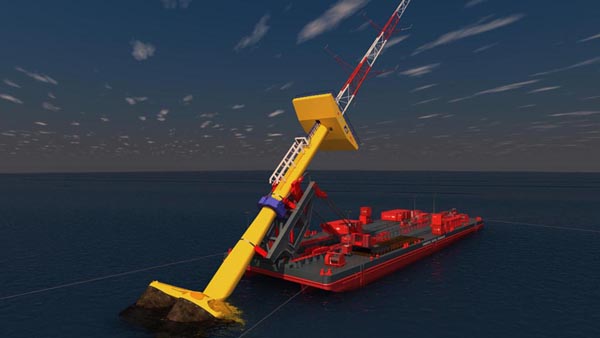 |
| EMI technology uses a standard barge equipped with a tilting frame in order to install monopiles or met masts with a multiple suction-bucket footing |
Driving down deployment costs also means finding the most efficient process for each offshore project – for example, whether to assemble the whole rotor onshore or to ship the blades and hubs individually and assemble them on-site. Lifting whole rotors means fewer offshore lifts and can be done in rougher weather, but racks of blades can be loaded more quickly at the quayside.
"You want the lowest cost solution for that particular set of components for that weather window," explains Sauven. "Water depth, time of year, distance from port: each changes the equation and you need the flexibility to optimise for each site."
Another choice is whether to ship turbine components out in smaller boats, giving better utilisation of the expensive on-site installation vessel. Specialist wind turbine installation vessels (WTIVs) can carry and install turbines and foundations themselves, but will be off-site when restocking back at the base port. With more demanding far offshore projects looming, the "mono-vessel" concept is gaining the upper hand.
"The available fleet of vessels require tugs and are much slower than the next generation new-builds, so there is no sense in using them to collect the components," says Katie Faulkner, A2Sea’s sales support manager. "Because Sea Installer has a larger capacity and is self-propelled, she will be able to 'cut out the middle man,' and collect the components directly from the production line, take them straight out to the site and carry out the installation."
The jack-ups currently used for turbine installation were mostly built for the oil and gas industry and adapted for wind, while the new WTIVs are bigger and more capable in every way, even compared to first generation installers like the MPI Discovery.
"These are absolute beasts in comparison to previous vessels," says Max Paterson, sales and marketing coordinator at Seajacks, whose own WTIV will arrive this year. "Existing boats have blade racks overhanging the front, but Zaratan can stack them across the back of the deck."
Today’s foundations can weigh over 700 tonnes, with nacelles tipping the scales at over 350 tons and towers in excess of 260 tons. Cranes must have the reach and radius to install these at more than 100 meters above sea level. Crane loads are going up from 300-600 tons to 800-1,200 tons or more, and employ a "wrap around the leg" design for optimum deck access.
New WTIVs have far more deck space with extra flexibility to cater for different projects, and can jack their heavier payloads in deeper water. DP2 capability comes as standard, transit speeds are higher, and accommodation allows for extra installation workers: all attributes intended to support far offshore deployment.
"At Thornton Bank, we were taking out one turbine per cycle," says Richard Hatton, head of UK offshore sales at REpower. "This year we were taking out two sets. The new vessels will be able to take six or seven sets per cycle."
RWE considers this area so important that it built its own boats and founded a dedicated company to manage all aspects of offshore logistics. Its two SeaBreeze class vessels are now working on the Nordsee Ost and Gwynt y Môr fields respectively. Contrary to fears of a shortage in only two or three years, there are now numerous WTIVs appearing on the market.
"Since we launched our plans, a lot of companies are building vessels. Every one is different, and in the next few years we will see which one is best," says a spokesman for RWE Innogy.
Swire Blue Ocean’s Pacific Orca exemplifies the new generation. It will have a 1200 tonne crane, a transit speed of 13 knots and accommodation for 111 people. With a deck area in excess of 4,000 m2 and an 8,400-ton jackable weight, it will operate in up to 75 meters of water.
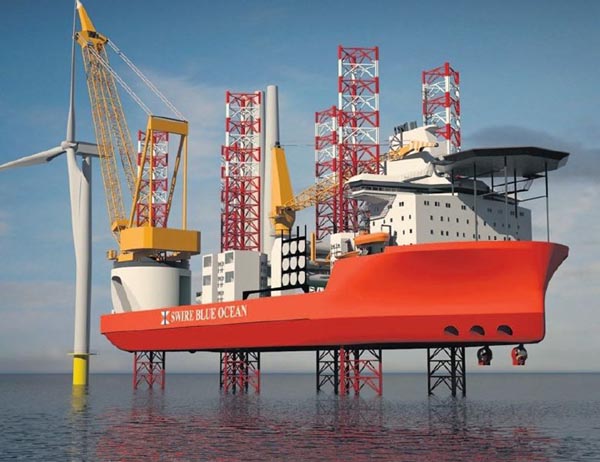 |
| Swire Blue Ocean’s Pacific Orca exemplifies the new generation |
Fred Olsen Windcarrier’s two boats, Brave Tern and Bold Tern, will be delivered in the second half of this year. "They are built to cope with a 10 MW turbine and a 470 tonne hub weight," says commercial manager Carl Erik Gurrik.
GeoSea’s Neptune will shortly start work on Thornton Bank while other new vessels due this year include Workfox’s Seafox 5, MPI’s Adventure and Discovery, another WTIV from Van Oord, and HGO InfraSea Solutions’ Innovation. The latter is the biggest yet, with a 1,500-ton crane and an 8,000-ton payload.
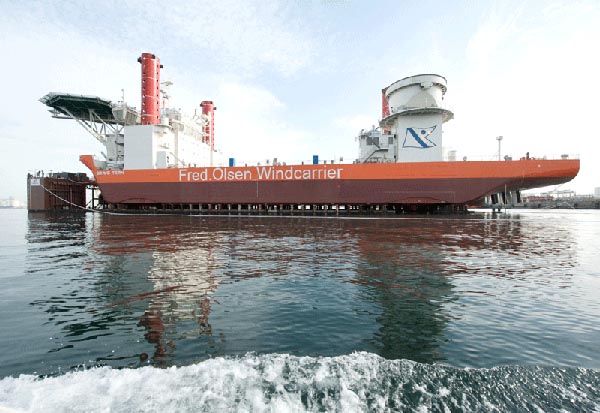 |
| Fred Olsen Windcarrier’s two boats, Brave Tern and Bold Tern, will be delivered in the second half of this year |
Deep water is the new frontier for turbine deployment. Going beyond 45 metres makes jacking impossible for almost all current vessels, and floating WTIVs would be the likely solution.
Dynamic stabilisation is an important technology here (and in all lifts involving floating vessels), reducing roll and so the dynamic crane loading, thus permitting relatively heavier lifts. Manufacturers like Liebherr are also working to improve the heave compensation systems already built into many marine cranes. "We lifted turbine components from floating vessels on the Beatrice Demonstrator in 45 meters of water," says Hatton. "It’s faster because there’s no need to jack but it cuts down on the weather window. Better dynamic stabilisation is coming but it’s still a long way from being proven."
Designers are now pushing vessel capability even further. For example, W3G Marine Ltd’s OWTIS (offshore wind turbine installation ship) concept offers a 1,500-ton crane. Gaoh’s twin-hull "offshore installation shuttle" would carry two complete turbines or foundations on a high gantry. Employing a combination of dynamic positioning along with both vessel and hoisting compensation systems would give it a claimed 80 percent operational window in the North Sea.
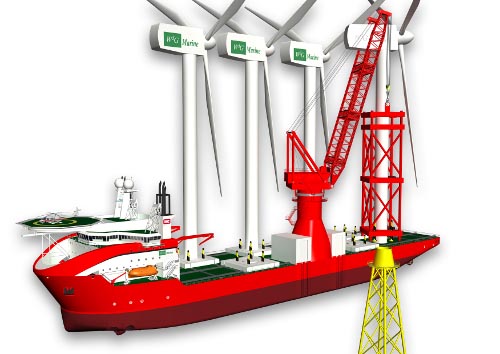 |
| W3G Marine Ltd’s OWTIS concept offers a 1,500-ton crane |
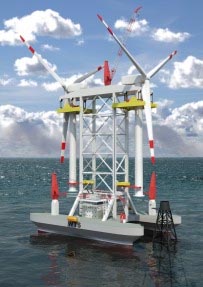 |
| Gaoh’s twin-hull «offshore installation shuttle» would carry two complete turbines or foundations on a high gantry |
Offshore wind development is often compared with the early days of North Sea oil exploration. Here, the comparison has real resonance. Manufacturers, developers and the rest of the supply chain are working flat out to use the latest logistics technology to access Europe’s massive offshore wind resource – safely, swiftly and at the lowest possible cost.
